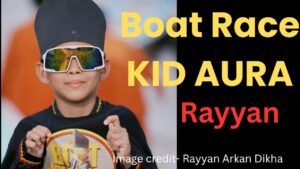Rayyan Arkan Dikha Biography 2025:
Rayyan Arkan Dikha: In the fast-paced world of show biz and social-media, fresh stars are unearthed daily, and the shooting stars—one after the other—are instantly loved and worshipped for what they do on-screen and off it. One of those up-and-coming names is Rayyan Arkan Dikha, a talented face who’s shot into the scene with real momentum, with light speed growth in acting, styling, or digital content production, depending on which space he’s formally in (please correct to context).
So, who is Rayyan Arkan Dikha? What’s his background and how did he become famous? This comprehensive biography reveals his formative years, early career, millennial success and the reasons why this superstar stands out in a competitive field.
Who is Rayyan Arkan Dikha?
Rayyan Arkan Dikha is an 11 year old born on December 28, 2014, hailing from Kuantan Singingi Regency, Riau province, Indonesia. He shot to worldwide fame after footage of him cutting a stylish rug on the deck of a traditional longboat went viral following the Pacu Jalur boat race. It was that single moment that made him an international meme and cultural symbol.
Rayyan Arkan Dikha was immersed in the local maritime culture from a young age. The second son of Rani Ridawati and Jufriono, at the age of eight Rustam already began riding along and training with his father in local boat races. His school didn’t offer formal dancing lessons, but Rayyan picked up the moves by observing and joining family training and has developed some serious balance and rhythm.
At nine, he was cast as Togak Luan, the bow dancer who helped spark rowers during a race. This took balance on a narrow prow and the skill to work in unison in order to “raise the crew”—demanding traditional work.
Rayyan Arkan Dikha Viral Story:
Although according to tradition Rayyan was a Pacu Jalur, his fame came in early months of 2025 when a video of him dancing at the bow was became viral. Dressed in traditional Teluk Belanga costume, including a Malay Riau headcloth and black sunglasses, Rayyan smoothly and rhythmically moved his hands—blowing kisses, rolling fists, and rocking ’side to side-while balancing atop the bow of a racing canoe over the Batang Kuantan River.
- He had later revealed the dance was 100% off the cuff: “I went up with the dance myself… it was just spontaneous.
- Social Media: Gaining a following on Instagram, TikTok, YouTube, etc.
- Local Projects: Modelling for dwarf models or an independent local film for small acting roles at this stage or indie theater productions.
- Viral Moments: A specific post or performance that took off in an unexpected way, garnering attention for bigger opportunities.
What Is “Aura Farming”?
Aura Farming A Gen‑Z or Gen‑Alpha term used to describe level grinding or easily building up charisma or emitting a cool energy in a confident and stylish manner. Rayyan’s serene expression, confident pose, and fluid moves made him the perfect embodiment of this trend. He was now known among social media users as a reaper—a playful take on his assumed unbeaten status” — in messages like,
“He’s named ‘the reaper’ because he never loses”.
His clip was soon being disseminated on platforms like TikTok and Instagram, accompanied by hashtags like #aura farming kid on boat and #BoatRaceKidAura, and millions of people around the world were watching.
Global Impact & Cultural Recognition:
Rayyan Arkan Dikha dance brought on recreations far and wide, not just from other people on social media, but even from a few celebrities and organizations. NFL star Travis Kelce, F1 driver Alex Albon, and football clubs such as Paris Saint-Germain shared tribute videos, the latter joking, “His aura made it all the way to Paris.” The Singapore Navy even posed on their ship in his boat position with the tongue in cheek caption: “Harvesting some sea‑riously good auras”.

Upon his return to Indonesia, Rayyan was appointed Cultural Ambassador for Tourism by the Governor of Riau, Abdul Wahid, himself, in July 2025, receiving a government scholarship for education—the effect of his effort in promoting regional culture in a positive light.
He later appeared with his mother and performed on national television program in Jakarta and met the Indonesia’s Ministers of Culture and Tourism, which further solidified his role as a cultural ambassador from local tradition to global digital fame.
Indonesian Boy Rayyan Arkan Dikha “Boat Dance”:
It is dangerous, standing on the gunwales of a fast-moving canoe and dancing around on the deck. Rayyan’s mother said she was worried that her son might fall or get hit with a paddle, but a rescue team was always on hand. A competent swimmer, Rayyan had grown accustomed to it after a few initial slips during practice.
Despite all his newfound success, Rayyan remains remarkably down-to-earth. He sheepishly acknowledges that, when friends point out, (he’s gone) viral, and he confesses he didn’t recognize many of the celebrities who emulated his moves. His dream? To become a police officer one day. And his advice to others? “Keep healthy so you can be like me.
Read More: Satish Kushwaha Biography in Hindi
Cultural continuity meets modern media:
Rayyan’s performance is based in millennia-old tradition and yet, in this global digital age, resounds with audiences around the world — a perfect fusion of native heritage and modern viral culture.
He didn’t plan or choreograph his dance. But it happened organically, the product of the moment, embodying the real confidence that audiences everywhere find compelling.
A tiny village in Riau, and then on the world stage—Rayyan demonstrates how a single video can propel cultural pride around the globe.
Conclusion:
Rayyan Arkan Dikha isn’t simply an internet phenomenon; he’s a potent symbol. There at the crossroads of tradition and trend, he embodies the idea that authenticity, pride in heritage, and a sense of young sass can be universal. His apparently spontaneous little bit of “aura farming” brought Pacu Jalur—and the rich heritage of Riau—into the present day.
Read More: Who Is Sufiyan Alam?